#dinosaur extinction layer
Explore tagged Tumblr posts
Photo

Dinosaur Extinction Layer Soil Sample – Genuine KT Boundary Iridium-Rich Earth (65.5 Million Years Old)
Authentic KT Boundary Extinction Layer Soil Sample – From the Fall of the Dinosaurs
Uncover a moment frozen in time with this genuine KT Boundary (Cretaceous–Tertiary) soil sample, collected from the historically rich fossil beds of Slope County, North Dakota, USA. This finely preserved sample dates back 65.5 million years and represents the exact moment the dinosaurs vanished from Earth.
Each vial contains a portion of Earth’s ancient surface, formed immediately after the impact of a colossal asteroid—believed to have struck near the Gulf of Mexico—triggering the extinction of approximately 75% of all life on Earth. Rich in iridium (an element rare on Earth but abundant in asteroids) and micrometeorites, this KT Boundary layer provides compelling evidence of one of the planet’s most catastrophic mass extinctions.
Discovered in the 1980s and validated by scientists across the globe, the KT layer marks the end of the Cretaceous and the beginning of the Tertiary period. The aftermath of this event shaped the future of evolution—paving the way for mammals to rise and dominate the Earth.
🌍 You are holding history: a physical remnant from the day the world changed forever.
📦 What’s Included:
1x Vial of KT Boundary soil sample
Informative label and origin details
Packaged in a protective case for display or study
🔬 Ideal for:
Paleontology enthusiasts
Geology and science collectors
Educational and display purposes
Dinosaur fans and future scientists
Own a piece of deep time. A legacy of cosmic impact. A link to the age of dinosaurs.
#KT Boundary soil sample#dinosaur extinction layer#iridium-rich soil#Cretaceous-Tertiary boundary#asteroid impact evidence#65.5 million year old sample#mass extinction layer#Chicxulub impact layer#paleontology specimen#geology collectible#real dinosaur era soil#extinction event sample#KT layer vial#fossil record evidence#science gift#educational geology sample#authentic KT boundary#dinosaur fossil era#asteroid extinction layer#rare earth element sample
0 notes
Text
You guys wanna see my prized possession?


Not only did I buy it certified but I also have a field geologist buddy who verified using his eyes. 😚
#kt boundary#chicxulub crater#kt extinction event#kaolinite layer#claystone layer#trace elements of iridium#Yucatan peninsula#cretaceous dinosaur extinction event#my post#my prized possession#lignite#luidilovins
33 notes
·
View notes
Text
I don't have any ideas yet so here's some Earth art so you don't get bored. (btw, the second picture is my first art with him).
And I'll add some of my silly headcanons about him


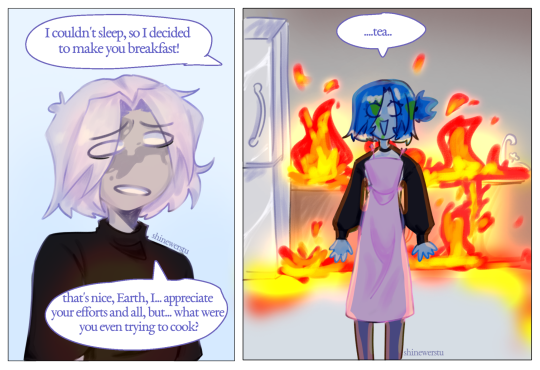
Earth has very active facial expressions and it looks really funny.
He has a habit of often looking at himself in the mirror, but not to admire himself, but to clearly make sure that everything is fine with earthlings. To see the continents that are on the back of his head, he can use two mirrors or ask Luna to look. This has led to the fact that he now looks at himself in any reflective surface without thinking.
He always dresses like a cabbage, heh. I mean, he wears several layers of clothing. This is to hide from the rest of the planets the damage to his body caused by earthlings.
He has ADHD
His dinosaurs became extinct when Mars hit him in the eye with an asteroid during a game, now Earth sees worse with his right eye than with his left, but does not tell Mars this so as not to remember it again and this would make Mars feel even more guilt.
He's ambidextrous, that is, he has both arms equally developed.
For some reason, he doesn't like wearing accessories like rings, bracelets, pendants or anything else.
Due to the activities of earthlings, he often suffers from insomnia
Maybe I'll change this later because I often forget my own headcanons.
283 notes
·
View notes
Text
A tiny who just wants to explore comes across a giant in a state.
content: g/t vore, multiple prey, implied fatal, unwilling prey, digestion, observer pov
–
You slip quietly into the room, your tiny footsteps barely making a sound on the cold, cemented floor. An abandoned warehouse. Or perhaps, to the giants, it was just a storage room.
Either way, you liked to wander and sneak around places where you probably shouldn’t go. It was part of your borrower instincts, you’d say. Urban exploration is a fairly normal hobby anyway, for both giants and tinies. The point is, you weren’t looking for trouble.
At first, everything looks normal for a condemned building—echo-y, dim, neglected, just the kind of place you’d been looking for.
But you have the sense that something isn’t right. A gut feeling—you can’t place it. You turn a corner and freeze.
A giant.
Your breath catches in your throat. The figure sprawled across the floor is immense, larger than any living being you’ve ever seen. From your minuscule perspective, the sheer scale of them is disorienting—no animal should be this large—it was like seeing a dinosaur; it should be extinct. It shouldn’t exist. But what really grabs your attention is their stomach.
It’s colossal.
You stare in shock at the massive, swollen curve of their belly, rising up like a hill in the center of the room. You’ve seen giants from afar, but never like this. Not up close, and not... like this.
The stomach is enormous—so much bigger than you, bigger than your car, even bigger than a house. It’s distended, rounded out in a tight, unnatural way that makes you start to realise something is wrong here. Are they sick?
The giant is passed out, their face relaxed in sleep, but their body tells a different story. Their stomach is so grotesquely distended, so unnaturally large, it looks painful.
And the sounds—oh god, the sounds. Despite any survival instinct you have, you inch closer, carefully stepping around their outstretched arm, your eyes fixated on their swollen midsection.
Deep, heavy gurgles reverberate from their gut, like the low rumbling of an earthquake, vibrating through the concrete beneath your feet. It’s so loud, so visceral, like standing next to an industrial machine. The noises make your skin crawl. Listen, as if in a horrible trance, to the groaning and churning of their stomach, struggling with whatever is inside.
And then, faintly, you catch something else.
Voices.
Your blood runs cold. Faint, muffled cries, barely audible beneath the thick layers of skin and muscle, but unmistakable. You edge closer, your eyes locked on the giant’s stomach, unable to look away. The voices are weak, but they’re there. It sets in with a sickening dread. There are people in there.
You take a step back, heart pounding in your chest as you realise what you’re hearing. The giant had eaten them—swallowed them whole, by the sound of it. You glance around the room; it’s still a nondescript warehouse interior. But you theorise the giant chose somewhere unassuming to hide while they...
Your stomach twists as you look back at the giant, their massive belly stretching up above you like a grotesque monument. You can’t help but imagine what it must be like inside, trapped in the tight, churning darkness of that giant’s gut, squeezed into the hot, suffocating space, with no way out.
You can’t believe what you’re seeing—what kind of person would do this?
The giant shifts slightly in their sleep, letting out a long, low groan. You flinch, stepping back, but they don’t wake. Their face is slightly vexed; it seems like a fitful sleep; this might have been too much, even for them.
But then, as you watch, their lips part, and a deep, thundering belch rolls out of their mouth. Their expression relaxes; it becomes peaceful even. They continue to lie there, completely unaware of the horror inside them.
The noise is deafening, shaking the air around you. You cover your ears, the sound reverberating in your chest like a subwoofer, a reminder of just how enormous this body is compared to yours. The belch is loud and lazy, almost careless, like the giant’s body is simply responding to the meal. Their stomach seems to stir, and the deep gurgles return, louder this time, more ominous.
You take a shaky breath, your eyes locked on that unnaturally large belly. The skin is stretched so tight it shines under the dim natural light, and you can see the faintest bit of movement beneath the surface—small bumps, appearing here and there.
Your mind reels, trying to comprehend the scale of it all. The stomach is so large, so engorged, and those voices... There must be at least a dozen, maybe more, trapped inside. You can hear them still, faint and muffled, like they’re buried deep under layers of sound. How many people had the giant swallowed? And how did they catch them?
You inch closer, trembling with fear and disbelief. From down here, the giant is like a living landscape, their body so vast it’s hard to take it all in. Their belly rises far above your head, towering over you like some grotesque monument. You reach out, not thinking, and place a hand against the tightly stretched skin.
It’s hot, like an overheated computer, and you can even feel a constant whirring. You can feel deeper and stronger vibrations, which coincide with the audible gurgling.
The sheer size of it makes you feel so small, so utterly insignificant. And inside that massive gut are people—people like you. Only what, a metre or so from where your hand is placed.
The giant lets out another soft groan in their sleep, and you jump, quickly stepping back again. Their body is so loud—every churn from the overstuffed organ is amplified to an almost unbearable degree.
Your thoughts race, panic rising in your chest. You have to get out of here. This giant is dangerous—a predator unlike anything you’ve ever imagined. The predator is asleep now, but what happens when they wake up?
You get the feeling that they wouldn’t still feel hungry...
But the fact that you’ve seen this means that you are a liability. You may be the only surviving witness to a terrifying crime.
You glance back at the direction from which you came. Your heart thuds in your chest. You can still hear the voices—desperate sounds of those trapped inside the giant’s stomach. But there’s nothing you can do for them. You’re too small, too helpless. You can do more for them by escaping and letting the world know what happened.
The giant stirs again, grumbling in their sleep, their bloated belly gurgling loudly, and you are once again frozen in place. You pray they don’t awaken.
Another belch escapes their lips, still so resonant. You have to get out of here.
You take one last look at the monstrous sight in front of you—the giant, passed out on the floor, their stomach swollen beyond belief—and then you turn and run.
143 notes
·
View notes
Text

I wanted to draw a dinosaur found in Italy, searching on the internet, i found a lot of information about Antonio.
The scientific name is Tethyshadros insularis, is an extinct species of dinosaur ornithopod hadrosauroid lived in the Late Cretaceous.
It was discovered by pure chance, while geologist Brazzatti was driven by the suspicion of a tectonic fault highlighted by a directional change in the calcareous layers, Brazzatti discovered the limb of a prehistoric dinosaur emerging from the ground.
This is so fascinating...
46 notes
·
View notes
Text

Iridium is incredibly rare on Earth, but is relatively abundant in meteorites. Scientists determined that an asteroid caused the non-avian dinosaurs' extinction when they found a high concentration of iridium in the layer of clay geologically separating the Cretaceous from the Paleogene era.
26 notes
·
View notes
Text
me: *taps microphone*
me: the age of the dinosaurs lasted for hundreds of millions of years and ended in less than 48 hours. within seconds of the meteor impact the entire planet was on fire. there is a global layer of black ash from those 48 hours.
me: if the asteroid had hit ten minutes earlier or ten minutes later, it wouldn’t have had as dramatic of an impact and while there would’ve been a mass extinction it would’ve mostly affected the ocean and that coastal area.
*security begins to drag me offstage*
me: the reason any of us exist at all is because of an incredibly rare cosmic event that had not happened before nor since in the hundreds of millions of years life on our planet has existed wake up america!!!!!
10 notes
·
View notes
Text
Cartoons with dinosaur people trying to make the earth hotter
A streamer I was watching watched some random episode of Extreme Dinosaurs and the villains were trying to use a weapon that destroys the ozone layer to make the earth hotter and more suitable for dinosaurs
Ozone is a greenhouse gas and removing the ozone layer makes the earth colder. Sunburn is not caused by the sun being hot it's caused by UV radiation which the ozone layer blocks.
There's also an episode of Batman Beyond where a cult is turning themselves into dino men and said cult wants to explode a super volcano in order to make the earth hotter and more suitable for dinosaurs.
Super volcano explosions in Earth's natural history are followed by long periods of cold weather due to the amount of ash being launched into the upper atmosphere and blocking sunlight. This was one of the theories of what made the dinosaurs extinct in the first place before we settled on the asteroid.
How are dino people so bad at making the earth hotter, us humans are doing it by accident.
#dinosaurs#Extreme Dinosaurs#Batman Beyond#Global Warming#There were plenty of dinosaurs that lived in cold snowy climates anyways so why do they even need to make the earth hotter
16 notes
·
View notes
Text
Okay so here's my idea based on the unused White Realm (Which will actually be today's Angeltober prompt!)
So basically, it might be called Pearl Gardens? Or something to that effect. It's a dreamy, ethereal realm, locked away from Worldless' gaze for quite a long time. And because of this... there's many unique starfolks and things that aren't found in any of the other realms.
Despite being associated with the colour white, it also have quite a bit of pastel colours too, as well as iridescence stuff. This realm is mainly comprised of Sky islands and clouds, with a large ocean beneath the cloud layer... which is ANOTHER hidden realm called the Abyssal Fields. There's many bridges and buildings, with stained glass windows being practically everywhere.
Most starfolks don't look like anything in the known realms, many of them here resemble medieval beasts, extinct animals or even be completely alien.
Some good examples would be:
Dracos- Resembles Medieval dragons. Comes in both polarities.
Hippalectryons- Dark
Pegasus - Light
Peryton - Dark
Jackalopes- Light
Barkscreech - Resembles thylacines. Comes in both polarities.
Cheepers - Resembles dodos. Light polarity
Skyblockers - Resembles Passenger pigeons. Dark polarity
Aricapeep - Resembles a "raptor" type dinosaur. Comes in both polarities.
Of course, this isn't an extensive list, and that's not talking about the Abyssal Fields.
Of course, being sealed away from Worldless' gaze, as well as the conflict itself, resulted in something... odd happening. The polarities amongst these starfolks seemingly got thinned out, resulting in these unique starfolks living in peace instead.
And maybe...
They're the only ones standing after the Universe was recreated...
20 notes
·
View notes
Text
Wet Beast Wednesday: emperor penguin
This is the last Wet Beast Wednesday before Christmas and Christmas is associated with the north pole thanks to Santa. So to celebrate the season, I'm going about as far away from the north pole as it is possible to go and talking about the emperor penguin. This also happens to be the first dinosaur I've showcased on this series.
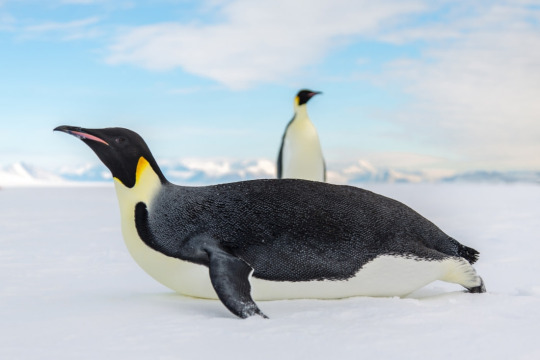
(image id: an emperor penguin lying belly-down on ice, seen from the side. Its back, wings, and head are black while its belly and neck are white. It has a patch of orange feathers near the ears. Another penguin is standing up in the background. end id)
Aptenodytes forsteri is the largest of all penguins and the sixth largest (by weight) bird in the world, only surpassed by the emu and two species each of the cassowary and ostrich. Those are all paleognaths, one of two living groups of birds, making the emperor penguin the largest of the other group: the neognaths. There are some discrepancies on their size due to the standards of bird measurement, but recent measurements list their standing height as reaching 120 cm (3.9 ft) with a weight of 22.7 to 45.4 kg (50 to 100 lbs). Their weight varies a lot during their lives, with both males and females losing a lot of weight during breeding season. Males generally weigh more than females. Genomic and anatomical analysis indicates that the emperor penguin, along with the closely-related king penguin and an extinct species, are part of a group of penguins that branched off of the family tree before the other living penguin species. As with other penguin species, they are heavily adapted for life in the water. All penguins are flightless, with their wings having adapted into flippers used for swimming. Penguins stand differently than other birds. Most birds have long legs and hold their bodies horizontally to the ground or at an angle, but penguins have short legs and hold their bodies vertically, like humans do. This, plus other adaptations, helps streamline the birds, letting them swim more efficiently. Like other seabirds, their feathers are very dense and coated with oil that repels water. This keeps the feathers from becoming waterlogged, reducing drag and helping keep the bird warm. During molting season, the feathers emerge from the skin mostly formed and push out the old feathers, preventing the penguin from developing bald or thin patched that would compromise insulation. While the feathers are responsible for most of the insulation, a layer of fat also helps. Like other birds, penguins are endothermic, commonly known as warm-blooded. Penguin tongues have backward-pointing barbs that help prevent food from escaping their mouths.
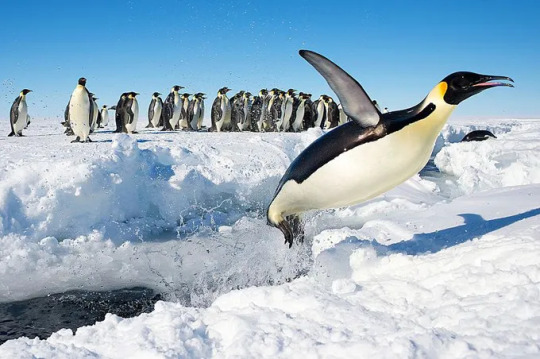
(image id: an emperor penguin jumping out of the water and onto ice. It is pictured in midair with its body roughly parallel to the ground and wings extended. Multiple other penguins are in the background. end id)
Emperor penguin's divide their year between the breeding season and the rest of their lives. During most of the year, they spend their time searching for food. Most of this food consists of fish, krill, and squid. Emperor penguins are social animals that often coordinate with each other to hunt in groups. While hunting, they will dive up to 535 meters (1,755 ft) and spend up to 21 minutes underwater before surfacing to breathe. During dives, the pressure can increase up to 40 times and the emperor penguin has some special adaptations to cope. Unlike most birds, emperor penguin bones are solid, reducing the chance of one breaking under pressure. During dives, the heartbeat slows dramatically and non-essential organs cease functioning to conserve oxygen in the blood. In addition, the hemoglobin in the red blood cells is modified to carry more oxygen in high pressure and low temperature. While on land, emperor penguins gather in colonies along the shoreline. Members of the colonies spend a lot of them time huddled against each other to keep warm. The penguins live all around Antarctica between 66 and 77 degrees southern latitude.
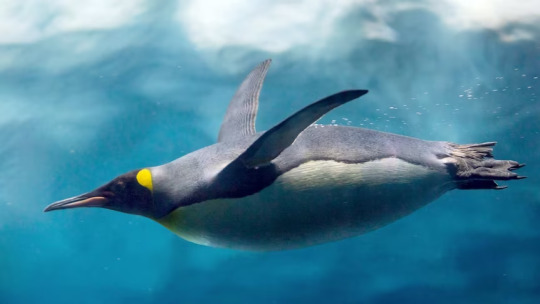
(image: an emperor penguin swimming underwater. Its head is pointed up, making its body very streamlines. Its wings are extended and are used for propulsion and steering. end id)
The thing emperor penguins are most famous for is their breeding behavior. Breeding season starts at the beginning of winter in Antarctica, between March and April, and is triggered by the decrease in day length. Penguin colonies travel inland en masse moving between 50 and 120 km (31 to 75 miles) to find a spot to raise their chicks. These spots are usually large, flat patches of sea or lake ice with a barrier such as a cliff or iceberg used to block the wind. Males perform sexual displays wherein they make loud courtship calls while wandering around the colony. When a female is interested, she will face they male and they will both hold their heads up for a few minutes. Once a pair os formed, they will walk around the colony together. When ready to mate, The pair will bow to each other. Emperor penguins are serially monogamous. They will only mate with one other penguin each season, but rarely pick the same mate more than once. The pair say together until the egg is laid in late May or early June. The female then transfers the egg (only one is laid every year) to the male, a tricky process. They have to use their feet to transfer the egg without dropping it. If the egg breaks or is exposed to the ice for more than a minute or so, it will die. It is not uncommon for an egg to be lost, especially in first-time parents. If this happens, both parents will leave the colony and return to the sea, not mating again until next year. The male balances the egg on his feet and covers it with a loose flap of skin. The bottom of this skin is a featherless patch called the brood patch that only forms during this season. By keeping the egg between his feet and the brood patch, the male incubates it. Once the egg is transferred, the female returns to the sea, leaving the male responsible for the next few months. In every other penguin species, the mother and father take turns incubating their egg. for the next 65-75 days, the male will incubate the egg in the middle of the Antarctic winter, where storms are frequent and temperatures can can reach into the -60s C (-70s F). He will not eat at all during this period, which, including travel and mating time, can last for 120 days. Males can lose up to half of their body mass during this fast. If the egg is dropped even once, it has a very high chance of dying. Walking without dropping the egg is tricky, but the males will form tight bunches to conserve body heat. These bunches are mobile, with members to the outside gradually moving inward and vice-versa. The egg usually hatches after around 60 days and it can take a few days to break out of its shell, which is thicker than in most bird species. The chicks are born featherless and will freeze to death if they leave the male's brood pouch. The male produces a substance called crop milk with a gland in his esophagus. Crop milk is unique to pigeons, flamingos, and male emperor penguins and is used to feed the chick. The crop milk does not provide full nourishment to the chick, but will keep it alive for about a week.
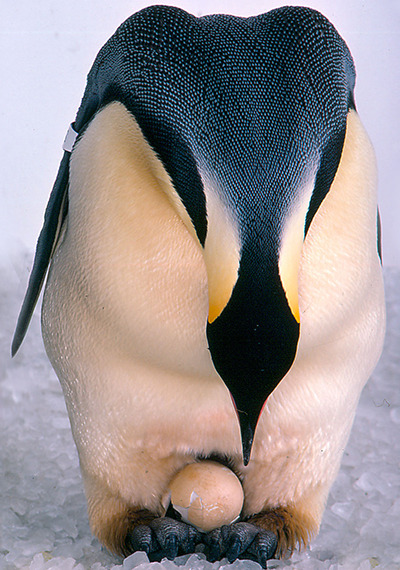
(image id: a male emperor penguin standing on ice with its egg balanced on its feet. The skin flap thet normally covers the egg is pulled back and the male is bending over to examine the egg. This egg is broken, possibly the result of being dropped, and is non-viable. end id)

(image id: a newly-hatched emperor penguin sitting on it's father's feet. It is very small and featherless, with grey skin and a black head. end id)
About this time, the female will return from her time at sea. She spent this time feeding and fattening herself up for the next leg of the parenting journey. She returns to the colony usually between 5 and 10 days after the hatching. If she arrives too late, the chick will starve. Once she arrives, she will locate her mate through the sound of his calls. The male then transfers the chick to the female's brood pouch and returns to the sea to feed and put weight on for another 3-4 weeks. The female will feed the chick by regurgitating half-digested food into its mouth. After this, the mother and father will take turns brooding the chick and feeding at sea. If either parent is delayed or dies, the chick will die as the remaining parent will eventually abandon it and return to sea. Orphaned chicks will try to seek food and shelter from other adults and mothers who have lost a chick may try to adopt an abandoned one, but as a single parent cannot raise a chick alone, it will eventually be abandoned as the adult goes to feed. Sometimes, a mother who lost her chick will attempt to steal a chick from another mother. This leads to fights over chicks that may leave chick trampled to death.
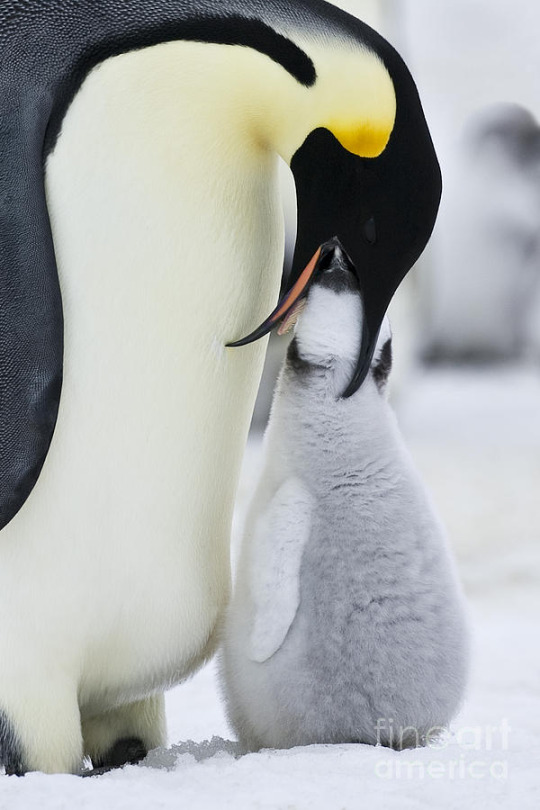
(image id: an adult emperor penguin feeding its chick. The chick is larger and covered in fluffy, grey, downy feathers. It no longer needs to stay on its parent's feet. The adult is looking down at the chick with its mouth open. The chick has its head inside the adult's mouth. end id)
Starting 45-50 days after hatching, the chicks now have a thick enough coat of down to survive outside of the brood pouch. Starting around this time, both parents will return to the sea and occasionally return to bring food, using the sound of their chick's vocalizations to track them down. When the parents are gone, the chick huddle together for warmth. Starting in early November, the chicks will start gaining their adult plumage and the adults will stop returning to feed them. Once they get hungry enough, the chicks will make the trip to the sea (which is shorter now as it is summer in the Antarctic and the sea ice has receded) and will be independent from now on. Only 15% of chicks survive their first year, but after that the survival rate is 95%, meaning most living emperor penguins are adults. Emperor penguins reach sexual maturity at 3 years, but most do not mate until they are 4-6 years old. The average lifespan of those who live long enough to reach adulthood is 20 years, but may live up to 50 years. The high survival rate of adults is in part due to a lack of predators. Adult emperor penguins are only hunted by leopard seals and orcas, though the former prefer juveniles. Juveniles are preyed upon by seals when they reach the water and by southern great petrels when on the ice. Adult emperor penguins lack any land predators, which has resulted in them having no prey response when on land. Scientists and antarctic explorers have reported that adults will approach them without fear.
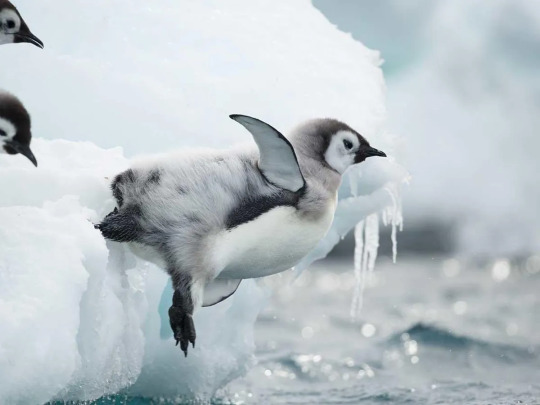
(image id: a newly-independent chick entering the water for the first time. It has not yet fully developed its adult plumage and has a mix of the chick's fluffy down and an adult's smoother coat. It is jumping off a ledge of ice into the water. Two other chicks watch from the side of the image. end id)
Emperor penguins are classified as near threatened by the IUCN, meaning they are losing population and may slip down into threatened status if conservation measures are not taken. The largest threat to emperor penguins is global warming reducing their habitat. Because they need sea ice to lay eggs and brood, the loss of sea ice every year has reduced the ability of the penguins to reproduce. in 2022, loss of sea ice led to a catastrophic failure to reproduce among nearly all known colonies. It is now estimated that 90% of colonies are at risk of dying out due to the loss of sea ice. If these trends are not reverted by reduction of global warming, the penguins could face extinction.

(Image id: two emperor penguins with their chick. The adults are standing behind the chick, which has its downy juvenile plumage. The chick stands about half the height of the parents. end id)
#wet beast wednesday#emperor penguin#penguin#marine biology#biology#zoology#ecology#animal facts#marine life#good parenting#cute#image description
124 notes
·
View notes
Text
Why Are Petrified Trees Trunks Fossilization Without Roots

My Theory Challenges the standard geology and mainstream Fossilization theory and the connection to dinosaur extinction :
• The mainstream theory say that fossilization requires burial under sediment, often by flood, volcanic ash, or landslides.
• In the case of roots, being the most buried part of a tree, should fossilize before or at least along with the trunk. Yet in many petrified forests worldwide:
• Trunks are perfectly petrified, often upright or lying sideways,
• Roots are missing, poorly preserved, or completely unmineralized. This contradicts the slow, uniform process expected under normal sedimentary fossilization.
Cosmic Flash Fossilization Explanation This phenomenon aligns well with the idea of a surface-directed energy event such as:
• A cosmic radiation burst.
• An electromagnetic pulse.
• Or a shockwave from a supernova or atmospheric plasma event These would:
• Strike the exposed upper portions of standing or fallen.
• Cause instant petrification of trunks above ground.
• Leave subterranean roots unaffected, as the energy could not penetrate the soil.
Supporting Visuals in Petrified Forests.
• Tree rings preserved in glass-like quartz structures.
• No sediment layering consistent with long-term burial.
• Surface alignment or orientation of trunks in similar direction (suggestive of energy flow or blast).
Petrification was not uniform, not gradual, and likely caused by a brief, external force acting only on exposed surfaces.
The Unified Petrification of Trees, Dinosaurs, and Marine Life
The Shared Characteristics Across Life Forms Petrified trees, dinosaur bones, and even some marine fossils exhibit:
• Quartz or silicate replacement of organic tissues.
• Exceptional detail in cellular or anatomical structures • Inconsistent or partial fossilization, often only on exposed surfaces.
• Unusual preservation of soft tissues (e.g., blood vessels in dinosaurs, inner bark in trees, soft-bodied marine fossils) This suggests that the mechanism of petrification was not selective by habitat (land vs sea), species, or burial depth—but rather acted universally and rapidly.
Evidence of a Single, High-Energy Event The preservation pattern across:
• Terrestrial megafauna (dinosaurs).
• Ancient forests (petrified wood).
• Marine species in sedimentary rock …points to a simultaneous exposure to the same cosmic flash event, possibly caused by:
• A supernova shockwave.
• A plasma burst or gamma-ray burst.
• Or a high-energy interstellar particle stream This would explain:
• Instant petrification on a global scale.
• Widespread distribution of fossilization regardless of environment. • The uniform mineral composition in fossils across continents.
*A Global Petrification Event This supports the hypothesis of a planet-wide petrification event, initiated by a cosmic force strong enough to:
• Penetrate the atmosphere and ocean surface.
• Interact with biological material at the atomic level.
• Mineralize tissues in seconds or minutes, not millennia This unified process dissolves the boundaries between geologic eras and environmental zones, replacing slow, local fossilization theories with a single, rapid cosmic event hypothesis.
Shared Preservation Traits Petrified trees, dinosaur fossils, and marine life show parallel fossilization patterns that suggest a shared, rapid petrification mechanism. Despite vast differences in habitat and structure, these organisms were subject to a similar mineralization process that preserved fine details and soft tissues. Across these biological categories, the following features are observed:
• Silicification and quartz-like mineral replacement of organic matter • Exceptional preservation of anatomical or cellular details.
• Partial or surface-focused petrification (outer fossilization, inner preservation).
• Fossils found in environments where slow fossilization by sediment is unlikely. These patterns challenge conventional models of localized, time-dependent fossilization. Indication of a Single High-Energy Cosmic Event The consistency of fossilization across life forms suggests exposure to the same type of cosmic energy, likely from a supernova or a related astrophysical event. This event could have:
• Released intense gamma radiation or plasma streams.
• Affected Earth’s atmosphere, oceans, and land surface simultaneously.
• Triggered mineralization of hydrogen-rich tissues at the molecular level This would explain why fossils in marine sediments, volcanic zones, and petrified forests share striking mineralogical and structural similarities.
Global Petrification Hypothesis I propose that a single cosmic event induced a wave of petrification across Earth’s biosphere. This mechanism:
• Worked at or near the speed of light causing Mineralized biological structures nearly instantly.
• Created long-lasting fossil records without the need for burial over millions of years This unifying process reframes fossilization not as a slow, isolated geological function, but as a short-lived, high-energy phenomenon of cosmic origin.
9 notes
·
View notes
Text
Throwback Thursday: The Father of Paleontology

This is Jean Léopold Nicolas Frédéric, baron Cuvier better known as simply George Cuvier. He was French naturalist and zoologist who is known for his work in comparative anatomy, specifically in regards to comparing fossils to living organisms. His work is considered the foundation of vertebrate paleontology because he expanded Linnaean taxonomy into phyla and included extinct animals.

In fact, he separated invertebrates and vertebrates which is a HUGE deal in biology. We've all learned the difference between those two major groups.
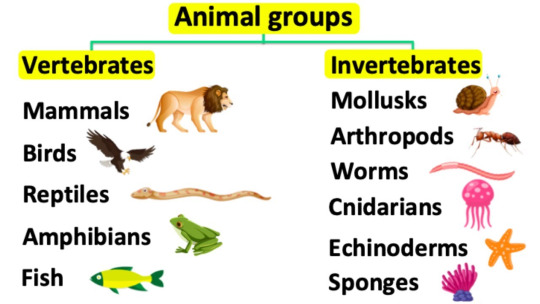
He also studied strata in the Paris basin Alexandre Brongniart which established the basic principles of biostratigraphy. They concluded that that the layers had been laid down over an extended period during which there clearly had been faunal succession and that the area had been submerged under sea water at times and at other times under fresh water. This led to the law of faunal succession which states that fossils appear and disappear in specific sedimentary rock strata.

He named many famous prehistoric animals we know today such as the Mastodon,

Megatherium,

and Pterodactylus.

He also described Mosasaurus.

He was a big proponent of catastrophism, the idea that the Earth's geological features were shaped by sudden, violent events. He was very against evolution which was primarily proposed by Jean-Baptiste de Lamarck and Geoffroy Saint-Hilaire at the time.

A deep-rooted source of his opposition to the gradual transformation of species was his goal of creating an accurate taxonomy based on principles of comparative anatomy. (This is why Linnaean taxonomy doesn't work and is not used by paleontologists today).

He was the first person to propose extinction though. His primary evidence for his identifications of mammoths and mastodons as separate, extinct species was the structure of their jaws and teeth. His primary evidence that the Megatherium fossil had belonged to a massive sloth came from his comparison of its skull with those of extant sloth species.


Many famous naturalists opposed his extinction theory including Charles Lyell and Charles Darwin. Unlike Cuvier, they didn't believe that extinction was a sudden process; they believed that like the Earth, animals collectively undergo gradual change as a species. This differed widely from Cuvier's theory, which seemed to propose that animal extinction was catastrophic.
We now know that both were right. Some extinctions are gradual while others are catastrophic. Just ask the dinosaurs.

He also speculated that there was a time when reptiles, not mammals were the dominant life forms on earth which was confirmed in the two decades following his death.

There's even more I can go into but for now, those are the big things he contributed to the science. Tune in tomorrow to learn about a well-known group of animals that appeared in the Ordovician Period. Fossilize you later!
#paleontology#fossils#geology#science#science education#fun facts#science history#biology#comparative anatomy#megatherium#mastodon#pterodactylus#catastrophism#biostratigraphy#vertebrates#invertebrates#extinction#phyla#mosasaurus
14 notes
·
View notes
Text
Fifteen years Chapter 2 X Will Poulter

MasterList
Will Poulter Masterlist
Chapter 1. 2. 3. 4. 5.

I didn’t sleep much that night.
Not because I was restless or anxious. But because I kept replaying everything his laugh, the way his hand fit around mine, the feel of his lips against mine. Like my brain didn’t want to risk forgetting a single second.
And apparently, neither did he.
The next morning, just as I was finishing my first cup of tea and debating whether to open the bookshop late in favour of a second one, my phone buzzed.
Will Poulter: If I said I’d bribe you with gingerbread and another mulled wine, would you come to Winter Wonderland with me?
I stared at the message for a moment, grinning.
Me: Depends. Are we talking actual bribes or just emotional manipulation?
Will Poulter: The first one. Maybe a little of the second.
Half an hour later, I was wrapped in three layers and walking toward Hyde Park with Will, our gloved hands already interlaced like it was the most natural thing in the world.
“So, how many years have you been secretly waiting to ask me out again?” I teased as we passed a row of market stalls selling ornaments and woollen hats.
He grinned, slightly sheepish. “Honestly? Since year ten. Just took me fifteen years and a very well-timed lip balm hunt to do something about it.”
“Truly fate at its finest,” I said, nudging him with my elbow.
He nudged me back, then promptly dragged me toward a stand selling hot chocolate piled high with cream and marshmallows. “Fuel. We need fuel before I attempt to win you an oversized plush penguin.”
We spent the next hour wrapped in the childlike joy that only a Christmas fair can bring. Will was exactly the same as he’d been when we were teenagers competitive, dramatic, and thoroughly determined to win at everything. Which meant I now had not one, but two ridiculous stuffed animals tucked under my arm.
“This one is you,” he said, holding up the sloth with a Santa hat. “Charming. Underestimated. Hangs onto things too long.”
“Rude,” I replied, laughing. “What does that make you, then?”
He held up the neon green dinosaur. “Undeniably cool and extinct. The full Will Poulter experience.”
It wasn’t until we were standing beneath the giant sparkling archway of lights that I realised my face was aching from smiling so much.
“God,” I murmured, staring up. “It’s beautiful.”
Will didn’t answer immediately. When I looked over, I found him watching me, a soft, unreadable expression on his face.
“Yeah,” he said. “It really is.”
My cheeks flushed with warmth that had nothing to do with the mulled wine.
We kept walking, and he slipped his arm around my shoulders like it had always belonged there. The wind picked up again, swirling snow-like flurries through the air, and for a second, the world really did feel like something out of a movie.
“You know,” he said after a pause, “when I left all those years ago, I kept meaning to write. Or call. But the longer I left it, the harder it got. I thought you’d have moved on. That you wouldn’t want to hear from me.”
“I was angry,” I admitted. “Hurt, mostly. But not because you left. Because you didn’t say goodbye.”
He stopped walking and turned to face me properly.
“I’m sorry. Really. I never stopped thinking about you, Y/n.”
I looked up at him, eyes stinging slightly in the cold. Or maybe not just the cold.
“I guess it’s lucky we ran into each other then,” I whispered.
He smiled, reaching out to tuck a strand of hair behind my ear. “Or fate. I’ll take either.”
We stayed like that for a moment, the noise of the fair falling away. Then he leaned down and kissed me again. This time slower. Surer. Like he knew he had time now. Like he wasn’t planning on vanishing again.
When we finally stepped back into the real world, blinking against the lights and the cold and the crowds, my phone buzzed.
Tasha (Book Club Queen): Reminder: Theatre Book Club at 6! Bring snacks or face the wrath.
I groaned. “Book club.”
Will raised an eyebrow. “Can I come?”
“It’s Les Mis this month. There will be tears and dramatic monologues.”
“Sounds right up my alley,” he said with a grin.
“You sure?” I asked. “My club members are… passionate.”
He stepped closer. “I like passionate.”
So that’s how Will Poulter ended up sitting in my tiny bookshop, wedged between a pile of beanbags and a stack of Dickens novels, holding court with half a dozen theatre nerds who were all utterly enamoured with him by the end of the night.
He read the last lines of Les Mis aloud, voice low and reverent, and the room went completely silent.
When it ended, Tasha leaned toward me and whispered, “You’re keeping him, right?”
I nodded, dazed. “Oh, I’m keeping him.”
After everyone had left, he helped me tidy up, arms brushing mine as we picked up mugs and stray biscuit crumbs. The shop was quiet and golden-lit, smelling faintly of old paper and cinnamon candles.
“I haven’t had a night like this in years,” he said, placing a worn copy of The Crucible back on the shelf. “Feels like home.”
I glanced at him. “Does that mean you’ll come back? After LA?”
He was quiet for a moment. Then he looked at me, eyes steady.
“I think I might. If there’s a reason to.”
“You’re fishing, Poulter.”
“Just confirming,” he said with a grin, “that I’m your favourite drama nerd.”
“Top two,” I teased.
He stepped closer. “Y/n.”
“Alright, alright,” I murmured, heart pounding. “You win.”
He kissed me then, right in the middle of the bookshop, between the Brontës and the Austens, with fairy lights blinking softly in the window.
And this time, I knew.
This wasn’t just nostalgia.
#fanfiction#reader#one shot#x reader#requested#will poulter imagine#will poulter#will#will poulter x reader#will poulter one shot#will poulter fanfic#poulter
14 notes
·
View notes
Text

Impact! 65 Million Years Ago - June 4th, 1996.
"What killed the dinosaurs? Their sudden disappearance 65 million years ago, along with about 70 percent of all species then living on Earth, is known as the K-T event (Cretaceous-Tertiary Mass Extinction event). Geologists and paleontologists often entertain the idea of a large asteroid or comet impacting the Earth as the culprit. Besides the firestorms, tidal waves, earthquakes, and hurricane winds such an impact would generate, the debris thrown into the atmosphere would have a serious global environmental impact - creating extended periods of darkness, low temperatures, and acid rains. In 1990, dramatic support for this theory came from cosmochemist Alan Hildebrand's revelation of a 65 million year old, 112 mile wide ring structure, still detectable under layers of sediment in the Yucatan Peninsula region of Mexico. The outlines of the structure, called the Chicxulub crater (named for a local village), are visible in the above representation of gravity and magnetic field data from the region. In addition to having the right age, the crater is consistent with the impact of an asteroid of sufficient size (6 to 12 miles wide) to cause the global disruptions. Regardless of the true cause of the K-T event, it is fortunate that such impacts are presently believed to happen only about once every 100 million years!"
32 notes
·
View notes
Text
About my main story: Purgatory.
But in a different way

These are the main elements of Earth, our planet. Water, "earth" and magma or fire.
More information ↓
In the beginning of everything, in the case of our planet, things were changing, evolving, and like anything that evolves, they create new lives.
This is no different here. The Elements are the embodiment of the elements without consciousness, they can walk, learn, transform and, depending on the element, adapt. Their form is entirely of their element, but they can change their body to almost any material.
And these three elements are one of the ancient elements, that is, before the radiation and the extinction of the dinosaurs, nowadays, they are extremely rare, and can only be found in Purgatory. Where radiation or external events do not easily enter.
But what is the relationship between the elements and Purgatory? Well, their birth created the new Layer.
14 notes
·
View notes
Text
There used to be parrots native to Carolina. They went extinct in the 40s. Besides the Green parakeet in Texas, it was the only parrot in the Continental US

A third of the biodiversity in the United States is at risk of Extinction
We're not just cutting down trees, we're bringing in invasive species, and we're changing the entire climate and we're doing nothing until it's too late
This isn't just the situation in the United States of course. This is happening everywhere.
Maybe we'll go extinct
Maybe we'll die out and life will just forget about us
The dinosaurs died out in the end KT extinction event because of a meteor. They burned. We know this because in the fossil record there is a layer of Ash.
Maybe there will be a layer of plastic
11 notes
·
View notes